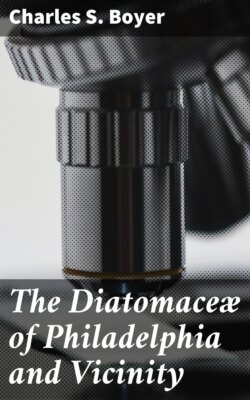Читать книгу The Diatomaceæ of Philadelphia and Vicinity - Charles S. Boyer - Страница 27
На сайте Литреса книга снята с продажи.
Actinoptychus Ehr. (1839) em. V. H. (1890)
Оглавление(actis, a ray, and ptyx, a fold)
Frustule cylindrical, less in length than the diameter, in zone view undulated. Valve divided into six or more sectors alternately raised and depressed, areolate and punctate, varying in the alternate divisions. The areolation is confined to the outer layer of the valve while the punctation is usually on an inner valve often found detached. Processes on the border, three or more. Umbilicus circular or angular, hyaline.
ANALYSIS OF SPECIES
| Sectors, six | undulatus |
| Sectors, eight or more, cellular | heliopelta |
| Sectors, fourteen, punctate | vulgaris |
ACTINOPTYCHUS UNDULATUS (KUETZ.) RALFS
Valve areolate and punctate in quincunx, divided into six equal sectors, alternately elevated or depressed, their areolations appearing different. Margin well defined. Umbilicus smooth, hexagonal. Processes three, sometimes six, inserted within the margin of each alternate division. Very variable in size and appearance.
This is the Actinocyclus of Bailey, figured and described in Amer. Jour. Science, 1842, p. 93, Pl. 2, Fig. 11, but not named. Kuetzing describes and names it and refers to Bailey.
Actinoptychus omphalopelta Ehr.
Actinoptychus cellulosa Ehr., H. L. Smith Sp. Typ., 384.
Quite common in marine and brackish water and in the blue clay.
Pl. 4, Figs. 1, 2, 4 and 6.
ACTINOPTYCHUS VULGARIS VAR. INTERRUPTA N. VAR.
Valve with fourteen sectors, the alternate ones divided by a smooth lanceolate space for about one-half the radius, forming with the smooth, circular umbilicus a seven pointed star. The sectors thus divided have coarser puncta in quincunx than the other sectors, ending in a smooth area near the margin, and also larger black puncta scattered from the centre to the semi-radius.
Near A. vulgaris var. neogradensis Pant.
Blue clay. Not common.
Pl. 4, Fig. 5.
ACTINOPTYCHUS HELIOPELTA GRUN. VAR.?
Valve circular, sectors, eight, umbilicus circular, without rays; border wide, cellular, with distinct rays. Inserted at a distance within the inner edge of the border are large processes, one on each of four alternate sectors, and two on each of the others. The sectors are cellulate and punctate.
Near A. heliopelta var. versicolor Brun., which, however, in the specimen in my collection from Atlantic City (artesian well), has a greater number of processes and they are situated on the edge of the border.
Outcrop at Buckshutem, N. J. Rare.
Pl. 4, Fig. 3.
It has been quite well determined, I think, that the typical forms of A. heliopelta occur at the base of the Miocene. At Rock Hall, Md., on the eastern shore of Chesapeake Bay, at a depth of from 21 to 130 ft., and at Wildwood, N. J., at a depth of from 78 to 179 ft., diatomaceous beds occur considered by Mr. Lewis Woolman (Geol. Surv. of N. J., 1898, pp. 116-121) "as synchronous in age," the former being deposited in the Delaware River Delta and the latter in the Chesapeake in post-miocene times. In each of these beds a small form of A. heliopelta is rarely found. The material at Buckshutem is post-miocene, and the form here figured shows a marked variation from the Miocene species and a gradual approach toward A. undulatus.
